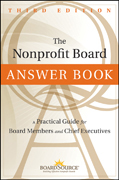
The nonprofit board answer book: a practical guide for board members and chief executives
An essential guide to good governance for board leaders at all levels of experience and expertise This third edition of the bestselling book for nonprofit board members and professionals offers a thoroughly revised and updated resource that answers the most-commonly asked question on board governance. The bookcovers such topics as board structure and process, board member recruitment and orientation, board-staff relations, and financial management. This new edition includes updated information on topics that have recently increased in importance including new Form 990; dealing with the financial crisis, risk management, and mergers. Shows executives and board members how to be more effective, meet difficult situations head-on, and deal with commonplace challenges withconfidence Topics include information on the viability of for-profit ventures, board retreats, board diversity, fundraising, financial oversight, strategicthinking, and the use of technology From Boardsource the premier resource forpractical information, tools, best practices, training, and leadership development for board members of nonprofit organizations worldwide Offers insight gained from the BoardSource Governance Index Survey, hundreds of board self-assessments, and questions and challenges heard by BoardSource from thousands of nonprofit leaders. INDICE: About BoardSource Introduction: The World of Nonprofits Part One: Basic Board Functions 1 What are the basic responsibilities of a nonprofit board? 2 What are the legal duties of a board member? 3 What is the board's role and involvement in mission, vision, and values? 4 What is the board's role in financial management? 5 What is the board's role in strategic planning? 6 How does strategic thinking contribute to board and organizational effectiveness? 7 What is the board's role in fundraising? 8 What is the board's role in organizational evaluation? 9 How does the board avoid the extremes of rubber stamping and micromanaging? 10 Why is connecting and communicating with constituencies an important task for the board? 11 How does a board function as a team? 12What are the attributes of a high-performing board? Part Two: Board Structure13 What is the best size for our board? 14 How should we structure our board?15 What types of board committees should we have? 16 How can our committees be most effective? 17 Does our board need an executive committee? 18 Should ourboard have advisory councils? 19 What is the role of the board chair? 20 Whatboard officers should we have? 21 How should we select our board officers? 22What kind of board does an all-volunteer organization have? Part Three: BoardMember Selection and Development 23 How can we recruit active, involved boardmembers? 24 How can we use a board matrix to identify recruitment needs? 25 What is the chief executives role in board recruitment? 26 How can a membershiporganization build an effective board? 27 How can our board become more diverse and inclusive? 28 What should we tell our prospective board members? 29 What should we include in our board orientation? 30 Should members of the same family serve on a board? 31 Should constituents serve on the board? 32 What should we do about uninvolved board members? 33 Should we have term limits for board members? 34 How can we engage former board members and chief executives? 35Should board members be compensated? 36 How can our board assess and improve its own performance? 37 Should individual board members be evaluated, and, if so, how? Part Four: Board and Committee Meetings 38 Is a board legally required to hold open meetings? 39 How often and where should we meet? 40 How can we improve our meetings? 41 How can we encourage debate while promoting civility in the boardroom? 42 What is the purpose of a board retreat? 43 Who should attend board meetings, and what are their roles? 44 How should staff members participate in board and committee meetings? 45 What are the different ways boardsmake decisions? 46 How should board minutes be written, approved, and kept? 47How can e-governance improve board and committee work? Part Five: The Board'sRole as a Fiduciary 48 How does a board help ensure the organization's long-term viability? 49 What does the board need to know about reserves and investments? 50 What is the board's role in the budge
- ISBN: 978-1-118-09611-6
- Editorial: John Wiley & Sons
- Encuadernacion: Cartoné
- Páginas: 384
- Fecha Publicación: 04/01/2012
- Nº Volúmenes: 1
- Idioma: Inglés
